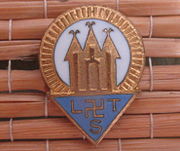Lithuanian Nationalist Union Lietuvių tautininkų sąjunga | |
|---|---|
 | |
| Leader | Antanas Smetona |
| Founded | August 1924 |
| Dissolved | June 1940 |
| Merger of | Party of National Progress, Lithuanian Farmers' Association |
| Succeeded by | Lithuanian Activist Front[1] |
| Headquarters | Vilnius, Lithuania |
| Newspaper | Lietuvis (1924–28) Lietuvos aidas (1928–40)[2][3] Vairas (1929–40)[4] Mūsų kraštas (1930–33) |
| Youth wing | Young Lithuania[5] |
| Paramilitary wing | Geležinis Vilkas (1927–30)[6] |
| Ideology | Authoritarianism Lithuanian nationalism[7] Corporate statism[8] National conservatism Anti-communism[9] |
| Political position | Right-wing[10] to far-right[a] |
| Religion | Roman Catholicism |
| International affiliation | Fascist International Congress (observer)[11] |
| Colours | Gold Blue |
^ a: In the 1930s, the party became increasingly more radical and sympathetic to Fascism.[12][10] | |
The Lithuanian Nationalist Union (Lithuanian: Lietuvių tautininkų sąjunga or LTS), also known as the Nationalists (Tautininkai), was the ruling political party in Lithuania during the authoritarian regime of President Antanas Smetona from 1926 to 1940. The party was established in 1924 but was not popular. It came to power as a result of the December 1926 military coup. From 1927 to 1939, the Council of Ministers included only members of the LTS. In 1936, other parties were officially disbanded, leaving LTS the only legal party in the country. At the end of the 1930s new members started bringing in new ideas, right wing and closer to Italian Fascism. The party was disestablished after the Soviet occupation of Lithuania in June 1940. A party of the same name (known as the Lithuanian Nationalist and Republican Union since 2017) was reestablished in 1990 and claims to be the successor of the interwar LTS.
- ^ Tadeusz Piotrowski, Poland's Holocaust, McFarland & Company, 1997, ISBN 0-7864-0371-3, Google Print, pp. 163-168.
- ^ Sužiedėlis, Simas, ed. (1970–1978). "Lietuvos aidas". Encyclopedia Lituanica. Vol. III. Boston, Massachusetts: Juozas Kapočius. pp. 340–341. LCCN 74-114275.
- ^ Kamuntavičius, Rūstis; Vaida Kamuntavičienė; Remigijus Civinskas; Kastytis Antanaitis (2001). Lietuvos istorija 11–12 klasėms (in Lithuanian). Vilnius: Vaga. pp. 396–397. ISBN 5-415-01502-7.
- ^ Urbonas, Vytas (2002). Lietuvos žurnalistikos istorija (in Lithuanian) (2nd ed.). Klaipėda: Klaipėdos universiteto leidykla. p. 160. ISBN 9955-456-49-3.
- ^ Kamuntavičius, Rūstis; Vaida Kamuntavičienė; Remigijus Civinskas; Kastytis Antanaitis (2001). Lietuvos istorija 11–12 klasėms (in Lithuanian). Vilnius: Vaga. pp. 385–386. ISBN 5-415-01502-7.
- ^ Berend, Iván T. (1998), Decades of Crisis: Central and Eastern Europe Before World War II, University of California Press, p. 134
- ^ Hiden, John and Salmon, Patrick; The Baltic Nations and Europe: Estonia, Latvia and Lithuania in the Twentieth Century; p. 56. ISBN 0582082463
- ^
Badie, Bertrand; Berg-Schlosser, Dirk; Morlino, Leonardo, eds. (7 September 2011). International Encyclopedia of Political Science. SAGE Publications (published 2011). ISBN 9781483305394. Retrieved 9 September 2020.
[...] fascist Italy [...] developed a state structure known as the corporate state with the ruling party acting as a mediator between 'corporations' making up the body of the nation. Similar designs were quite popular elsewhere in the 1930s. The most prominent examples were Estado Novo in Portugal (1932-1968) and Brazil (1937-1945), the Austrian Standestaat (1933-1938), and authoritarian experiments in Estonia, Romania, and some other countries of East and East-Central Europe.
- ^ Eidintas, Alfonsas (2015). Antanas Smetona and His Lithuania: From the National Liberation Movement to an Authoritarian Regime (1893-1940). On the Boundary of Two Worlds. Translated by Senn, Alfred Erich. Brill Rodopi. p. 149. ISBN 9789004302037.
- Eidintas, Alfonsas (2015). Antanas Smetona and His Lithuania: From the National Liberation Movement to an Authoritarian Regime (1893–1940). On the Boundary of Two Worlds. Translated by Alfred Erich Senn. Brill Rodopi. p. 301. ISBN 9789004302037.
- ^ a b Cite error: The named reference
tamoswas invoked but never defined (see the help page). - ^ Griffin, Roger. The Nature of Fascism St. Martin's Press, New York. 1991, page 121
- ^ Payne, Stanley G. (1995). A History of Fascism, 1914–45. University of Wisconsin Press. p. 145. ISBN 978-0-299-14874-4.